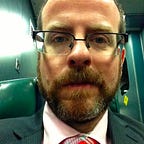Looking Out, Being Lean, Leaning In
M. Scott Havens is working it. Havens, President of The Atlantic, has taken Quartz and Defense One live in the past twelve months, and he’s re working the Wire as a product standing alone from The Atlantic mothership. He’s done all of this within the orbit of that mothership.
“The Atlantic incubated it in so many ways, but going forward this is about the Wire truly growing up and reaching millions of readers on its own.”
Nurturing without strangling on-the-vine is a tough balance to strike. Fostering new thinking in existing orgs fails more often than it succeeds, and it’s a full-time job working to make it happen either way.
When Tim Forbes initially invested in Lewis Dvorkin’s new News platform — True/Slant, where I was CTO — Mr. Forbes didn’t want the startup housed in Forbes’ offices. He knew there’d be interference and he didn’t want any. We built and grew True/Slant without the concern or comfort of a legacy business to attend. The business, platform and product had the opportunity to solidify. Two years later, Forbes acquired True/Slant’s proven model outright. They got a deeply-aligned team to disperse throughout the organization to drum the message home. Then drum repeatedly thereafter.
Havens built out The Atlantic’s last three major new brands from outside the bridge of the mothership. He’s got an NYC office where he’s fostered new products and new thinking within the 156-year old DC-based org. These have been explicit decisions. During his discussion at Digiday’s Publishing Summit, Havens expressed interested in allowing new thinking to occur outside the wider concerns of the larger organization, dig into what works and doesn’t, and to then fold lessons learned back into it.
Even with the core True/Slant team placed at high-levels throughout Forbes in the summer of 2010, nothing happened overnight. There was a skunkworks project to kick it off, an initial few months of extra-organizational table-setting to usurp the status quo in platform and product stack, and another few months outside existing hierarchy to recruit and onboard more schooled in The New Way. Successes showed from early on, but even with support top-to-bottom, it was still a year-plus effort to effect significant culture change.
Havens was working to launch Condé Nast Portfolio when we first met in 2006. Portfolio hired an outstanding roster of talent. They had an incredible amount of resources available. They had priority attention from services shared by the rest of Condé — or so it seemed to several of the other brands with whom I worked at the time. This while the launch team all worked outside the president’s door, literally, on the executive floor in the thorax of the mothership in Times Square. This was not a Lean organization. By standards of the parent company, Portfolio the print product was not a success. With the resources it used to launch and its ongoing overhead, it would have been difficult to be otherwise. Portfolio.com now redirects to upstart.bizjournals.com. Reversing the approach — starting online, building a brand, then launching a print edition if there was a market — would have been less splashy, but also less risky. This latter approach could still be taken today, even with the same brand.
Grays struggle to exist in larger organizations. There are vested interests, existing processes, lines of business and sources of revenue that make things Black or White to many people. False dichotomies like aggregation vs curation, staffers vs contributors and algorithms vs editors are some those The Established love to pit against each other. Re aggregation and algorithms, Havens said
“I like to use the word curation … As much as people talk about algorithms, human editors have become more and more important.”
Arming good editors with great tools, and getting better results than either would on their own, is battle-tested and proven true. Infusing original stories with flavors of the wider web is a formula that provides relevance and dynamism. Augmenting a core editorial staff with other voices and perspectives deepens and widens coverage potential, and it can spur everyone to improve their work. It’s not either / or — it’s both.
Senior management teams of going concerns aren’t dummies. When exploring new products and partnerships, they’re looking outward, starting lean, and leaning those resources back into the wider organization. This has been working with starting new businesses; what about for revitalizing existing ones? Working across lines of business and brands — bringing collective value to all while making each feel special — is a skill that takes time to develop and execute to. Time is a luxury, and one not many traditional publishers have as they work to develop businesses on the web, mobile, tablets, apps. Established companies with established brands can nurture and provide cover. They also provide challenges to changes of business and thinking. M. Scott Havens has struck a balance that’s been working.
